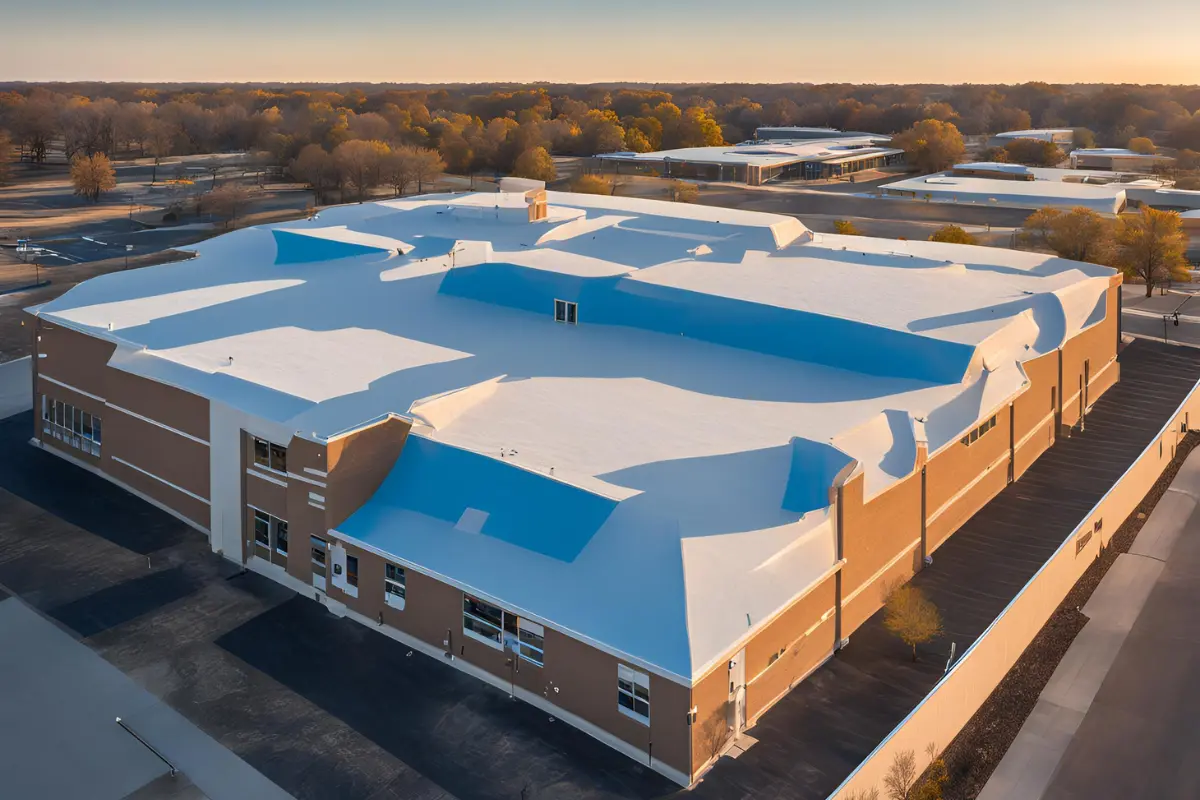School districts face constant budgetary pressures, and maintaining aging school buildings can be a significant financial burden. Among these expenses, roofing repairs and replacements often rank high, demanding significant investments and disrupting the learning environment. However, a proactive approach to roof maintenance can mitigate these costs and ensure a more durable and energy-efficient building envelope. This article explores the compelling reasons why schools in and around Wichita, KS should seriously consider polyurethane spray foam roofing as a strategic investment.
The Case for Spray Foam Roofing:
Polyurethane spray foam roofing has emerged as a leading solution for commercial and industrial applications, and its benefits are particularly relevant for educational institutions. Here’s why:
- Exceptional Durability and Longevity: Spray foam forms a seamless, monolithic membrane that adheres directly to the existing roof deck, eliminating potential leak points at seams and penetrations. This creates a highly durable and long-lasting roof that can withstand harsh weather conditions, including the strong winds and occasional hailstorms that can affect the Wichita area.
- Superior Insulation: Spray foam provides outstanding insulation, significantly reducing energy consumption for heating and cooling. This translates to substantial cost savings on energy bills, freeing up funds for other essential educational programs. Furthermore, improved energy efficiency contributes to a more comfortable learning environment for students and staff, enhancing focus and productivity.
- Waterproofing Excellence: Spray foam creates a completely impermeable barrier against water infiltration, preventing leaks, mold growth, and structural damage. This protects the building’s integrity and ensures a safe and healthy environment for occupants.
- Reduced Maintenance Costs: Unlike traditional roofing materials that require frequent inspections, repairs, and replacements, spray foam roofs demand minimal maintenance. This significantly reduces long-term maintenance costs and minimizes disruptions to the school schedule.
- Noise Reduction: Spray foam exhibits excellent sound-dampening properties, effectively mitigating noise pollution from outside sources. This creates a quieter and more conducive learning environment, especially in schools located near busy roadways or airports.
- Versatility: Spray foam can be applied over most existing roof surfaces, including metal, concrete, and wood. This flexibility allows for seamless integration with existing building structures and minimizes the need for extensive tear-offs, reducing construction waste and environmental impact.
- Environmental Benefits: Spray foam roofs contribute to a more sustainable built environment by reducing energy consumption and minimizing the environmental impact associated with traditional roofing materials.
Addressing Concerns and Considerations:
While spray foam roofing offers numerous advantages, it’s crucial to address potential concerns:
- Cost: While the initial investment may be higher than some traditional roofing options, the long-term cost savings associated with energy efficiency, reduced maintenance, and extended lifespan make spray foam a cost-effective solution over the long term.
- Professional Installation: Proper installation is critical to ensure the longevity and performance of a spray foam roof. It’s essential to engage experienced and certified contractors specializing in spray foam roofing applications.
A Call to Action for Wichita School Districts:
Given the significant benefits of spray foam roofing, school superintendents and board members in Wichita and surrounding areas should:
- Conduct thorough research: Investigate the long-term costs and benefits of spray foam roofing compared to traditional options.
- Consult with experienced roofing contractors: Seek expert advice from reputable contractors specializing in spray foam roofing to assess the suitability and feasibility of this solution for specific school buildings.
- Prioritize energy efficiency: Recognize the importance of energy efficiency in reducing operating costs and creating a more sustainable learning environment.
- Explore funding options: Investigate potential funding sources, such as energy efficiency grants and rebates, to offset the initial investment in spray foam roofing.
- Consider a phased approach: Implement spray foam roofing on a phased basis, starting with the most critical or energy-intensive buildings.
By embracing spray foam roofing technology, Wichita schools can significantly improve the durability, energy efficiency, and overall performance of their buildings while creating a more sustainable and cost-effective learning environment for future generations.
Disclaimer: This article provides general information and should not be considered professional advice. School districts should consult with qualified roofing contractors and conduct their own due diligence before making any decisions regarding roofing projects.




